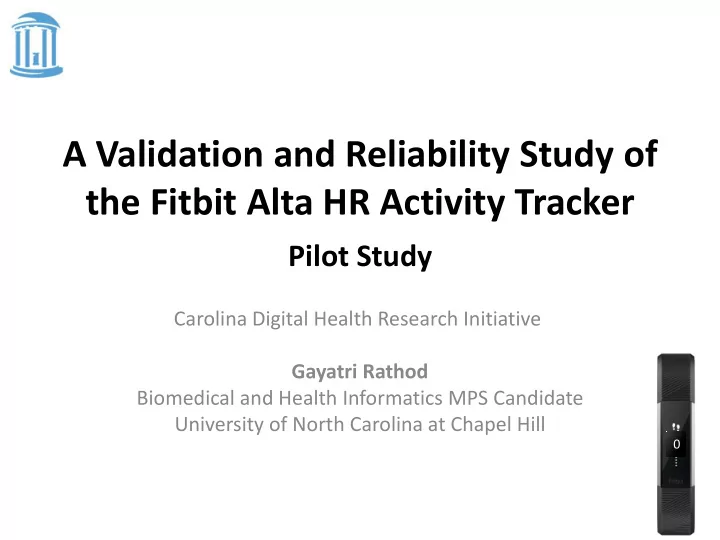

A Validation and Reliability Study of the Fitbit Alta HR Activity Tracker Pilot Study Carolina Digital Health Research Initiative Gayatri Rathod Biomedical and Health Informatics MPS Candidate University of North Carolina at Chapel Hill 0 0
Outline Background and Process and Study Methodology Objectives Design Results Insights 1
2
Research Studies Relevant to Fitbit 3 • Fitbit studies
Research Studies Relevant to Fitbit 4 • Fitbit studies • Validation
Research Studies Relevant to Fitbit 5 • Fitbit studies • Validation • Activity
Research Studies Relevant to Fitbit 6 • Fitbit studies • Validation • Activity • Adults
Objectives • Fitbit Alta HR validation for activity-tracking adult populations • Standardized protocol for digital accelerometer device testing for dissemination • IRB approval process and requirements for device validation 7
Protocol and Study Design • Fitbit device validation protocol required to meet the UNC IRB review • Methodologies were developed into three phases Phase 1: Orbital Shaker Validation • Highly controlled oscillation frequencies to simulate changes in movement for free-living environment 8
Phase 1 Results • Data too little and too inconsistent to evaluate • Suggests that the step count algorithm goes beyond simple xyz-axis movement • Suggests the ability of Fitbits and actigraphs to record step count data at lower frequencies is insignificant 9
Phase 2: Structured Activity Participant Recruitment Sample Characteristics (N=8) Gender, n Female 4 Male 4 Occupation, n Undergraduate 4 Postgraduate 2 Staff 2 Age in years, mean (SD a ) 33.25 (8.6) Body mass index in kg/m 2 23.175 (2.9) Number of valid 1-min epochs contributed Repeat b (Sample 1 only) Phase 1: Shaker table 200 Phase 2: Structured activity treadmill session 15843 Phase 3: 4-day free-living period 10
Phase 2: Study Design • Measuring for construct and criterion validity • 2 treadmill sessions with structured activity • 5 speeds based on the systematic review • Two actigraphs, 1 Fitbit, video step count 11
Phase 2: Results 12
Phase 2: Results 13
Phase 2: Results 14
Phase 3: Free-Living Activity • Measuring for construct validity • Participants logged activity intensity and type of activity while wearing the devices for 4 days • Waking hours, water-free • More than 8 hours of non-wear time were omitted 15
Phase 3: Results 16
Insights and Lessons Learned • “Failure” – proving the null hypothesis about phase 1 • Confirmation – data better at higher speeds • Learning experience – creating a protocol and IRB process • Challenges – access to study team and coordination – data extraction, problems and hacks 17 – data quantity and short intervals
Future Steps • Further in-depth correlation and mixed linear model analysis of the phases 2 and 3 need to be conducted • Ascertain Fitbit Alta HR validity across multiple speeds and activities • More participant recruitment so that stronger patterns may be concluded from the data • Finally, a white paper protocol of this study would be disseminated upon its completion 18
Brian Moynihan Fei Yu Derek Hales Robert Furberg 19
Recommend
More recommend